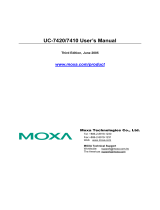
Table of Contents
1. Introduction ...................................................................................................................................... 1-1
Overview ........................................................................................................................................... 1-2
Software Specifications........................................................................................................................ 1-2
Software Components ......................................................................................................................... 1-3
2. Software Configuration ..................................................................................................................... 2-1
Account Management .......................................................................................................................... 2-2
Starting from a VGA Console ................................................................................................................ 2-3
Setting up Desktop Environments ......................................................................................................... 2-3
Connecting from an SSH Console .......................................................................................................... 2-4
Windows Users ........................................................................................................................... 2-5
Linux Users ................................................................................................................................ 2-5
Adjusting the System Time .................................................................................................................. 2-5
Setting the Time Manually ............................................................................................................ 2-6
NTP Client .................................................................................................................................. 2-6
Updating the Time Automatically ................................................................................................... 2-7
Enabling and Disabling Daemons .......................................................................................................... 2-7
Executing Scheduled Commands Using the Cron Daemon ........................................................................ 2-9
Inserting a USB Storage Device into the Computer ............................................................................... 2-10
Checking the Linux Version ................................................................................................................ 2-11
Installing and Removing Packages Using APT ....................................................................................... 2-11
Setting Up a Desktop Environment...................................................................................................... 2-13
Power Management—Suspend ............................................................................................................ 2-14
Wake On LAN ................................................................................................................................... 2-14
3. Managing Communications ............................................................................................................... 3-1
Renaming the Network Interfaces ......................................................................................................... 3-2
Changing the Network Settings ............................................................................................................ 3-2
Editing the Interfaces Configuration File ......................................................................................... 3-2
Adjusting IP Addresses with “ifconfig” ............................................................................................ 3-5
DNS Client ......................................................................................................................................... 3-5
/etc/hostname ............................................................................................................................ 3-5
/etc/resolv.conf ........................................................................................................................... 3-5
/etc/nsswitch.conf ....................................................................................................................... 3-6
Configuring Ethernet Bonding ............................................................................................................... 3-6
Apache Web Server ............................................................................................................................. 3-8
Install the apache web server ....................................................................................................... 3-8
Default Homepage ....................................................................................................................... 3-8
IPTABLES .......................................................................................................................................... 3-8
IPTABLES Hierarchy ..................................................................................................................... 3-9
iptables Modules ....................................................................................................................... 3-10
Observe and Erase Chain Rules ................................................................................................... 3-11
Define Policy for Chain Rules ....................................................................................................... 3-12
Append or Delete Rules .............................................................................................................. 3-12
NAT (Network Address Translation) ..................................................................................................... 3-13
NAT Example ............................................................................................................................ 3-13
Enabling NAT at Bootup .............................................................................................................. 3-14
PPP (Point-to-Point Protocol) .............................................................................................................. 3-15
Connecting to a PPP Server over a Simple Dial-up Connection ......................................................... 3-15
Connecting to a PPP Server over a Hard-wired Link ........................................................................ 3-16
Checking the Connection ............................................................................................................ 3-17
Setting up a Machine for Incoming PPP Connections ...................................................................... 3-18
PPPoE .............................................................................................................................................. 3-19
NFS (Network File System) Client ....................................................................................................... 3-21
SNMP (Simple Network Management Protocol) ..................................................................................... 3-22
OpenVPN ......................................................................................................................................... 3-23
Install the openvpn .................................................................................................................... 3-23
Ethernet Bridging for Private Networks on Different Subnets ........................................................... 3-24
Ethernet Bridging for Private Networks on the Same Subnet ........................................................... 3-27
Routed IP ................................................................................................................................. 3-28
4. Programming Guide .......................................................................................................................... 4-1
Device API ......................................................................................................................................... 4-2
RTC (Real Time Clock) ......................................................................................................................... 4-2
UART ................................................................................................................................................ 4-2
Programmable LED, Power Indicator, and Relay control ........................................................................... 4-3
WDT (Watch Dog Timer) ...................................................................................................................... 4-4
Introduction................................................................................................................................ 4-4
Watchdog Usage ......................................................................................................................... 4-4
How the WDT Works .................................................................................................................... 4-4
























